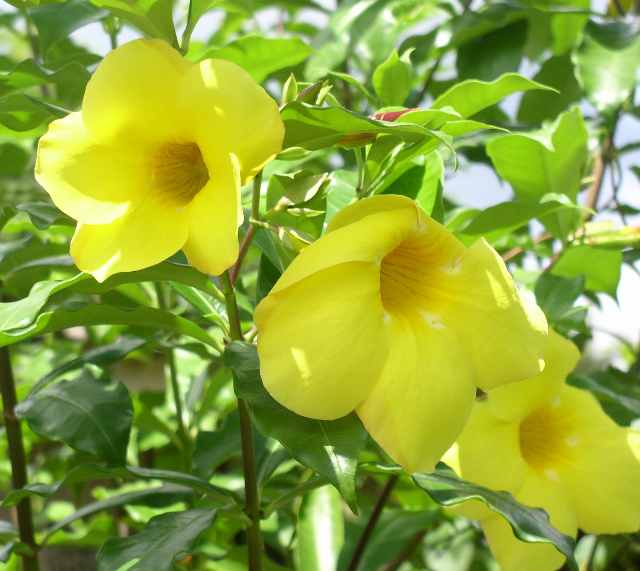- Allamanda
Taxobox
name = "Allamanda"

image_width = 240px
image_caption = Golden Trumpet ("Allamanda cathartica")
regnum =Plant ae
divisio = Magnoliophyta
classis = Magnoliopsida
ordo =Gentianales
familia =Apocynaceae
genus = "Allamanda"
genus_authority = L.
subdivision_ranks = Species
subdivision = See text.Allamanda, also known as Yellow Bell, Golden Trumpet or Buttercup Flower, is a genus of tropical shrubs or vines belonging to the dogbane family (
Apocynaceae ).The genus "Alamanda " is native to South and
Central America . Their year-round production of large, bright flowers have made the Allamanda popular ornamentals.A woody, evergreen shrub with vigorous growth, Allamanda may reach a free-standing height of 2 metres or more. The leathery leaves are lancelike, pointed, and may either be opposite or in whorls of three or four. The yellow, trumpet-shaped flowers are 5-7.5 centimetres in diameter; cultivated forms tend towards larger blooms which may also be white, purple, pink or orange in colour. Their scent may be described as delicate and fruity.
In the wild, Allamanda grow along riverbanks and other open, sunny areas with adequate rainfall and perpetually moist substrate. The plants do not tolerate shade, salty or alkaline soils; they are highly sensitive to frost. Allamanda are otherwise undemanding and with appropriate conditions will grow rapidly, from 1-3 metres annually. The seed capsules are oval and prickly; cultivated forms rarely produce seeds, but Allamanda are easily propagated from cuttings. Discarded cuttings are quick to take root.
Allamanda have become naturalized throughout the tropics; they may be seen in roadside ditches, abandoned yards and dumps. As a controlling measure, cutting is ineffecive with Allamanda and will lead to vigorous
coppicing . Owing to its fast growth, Allamanda has been introduced widely where it is used as agroundcover or for hedges and screens. In some areas Allamanda are aninvasive species , notably "Allamanda cathartica" inQueensland ,Australia ."Allamanda cathartica" is also notable for its medicinal properties: all parts of the plant contain
allamandin , a toxiciridoid lactone . The leaves, roots and flowers may be used in the preparation of a powerful cathartic (hence the name); the milky sap is also known to possessantibacterial and possiblyanticancer properties. Gardeners exposed to the sap will develop rashes, itch, and blisters.The genus name "Allamanda" derives from Dr.
Frederich Allamanda (1735-1803), a Swiss botanist of the late 18th century.Species
*"
Allamanda angustifolia "
*"Allamanda aubletii "
*"Allamanda blanchetii " (syn. "Allamanda violacea") Purple Allamanda, Violet Allamanda
*"Allamanda brasiliensis "
*"Allamanda cathartica ": Golden-trumpet, Large Yellow Bells, Brownbud Allamanda, Yellow Allamanda
*"Allamanda doniana "
*"Allamanda grandiflora "
*"Allamanda hendersoni "
*"Allamanda laevis "
*"Allamanda latifolia "
*"Allamanda linnei "
*"Allamanda magnifica "
*"Allamanda martii "
*"Allamanda neriifolia "
*"Allamanda nobilis "
*"Allamanda oenotheraefolia "
*"Allamanda parviflora "
*"Allamanda polyantha "
*"Allamanda puberula "
*"Allamanda salicifolia "
*"Allamanda schottii ": Bush Allamanda
*"Allamanda setulosa "
*"Allamanda thevetifolia "
*"Allamanda verrucosa "
*"Allamanda verticillata "
*"Allamanda wardleyana "
*"Allamanda weberhaueri "
*"Allamanda williamsii "See also
List of garden plants External links
* [http://www.fs.fed.us/global/iitf/pdf/shrubs/Allamanda%20cathartica.pdf USDA: Allamanda cathartica] (PDF file)
*pt icon [http://florabrasiliensis.cria.org.br/search?taxon_id=1424 Flora Brasiliensis: "Allamanda"]
Wikimedia Foundation. 2010.
